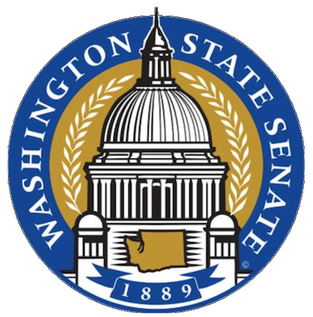
The Vermont General Assembly is the legislative body of the state of Vermont, in the United States. The Legislature is formally known as the "General Assembly", but the style of "Legislature" is commonly used, including by the body itself. The General Assembly is a bicameral legislature, consisting of the 150-member Vermont House of Representatives and the 30-member Vermont Senate. Members of the House are elected by single and two-member districts. 68 districts choose one member, and 41 choose two, with the term of service being two years. The Senate includes 30 Senators, elected by seven single-member and nine multi-member districts with two or three members each. It is the only state legislative body in the United States in which a third party has had continuous representation and been consecutively elected alongside Democrats and Republicans.

The California State Senate is the upper house of the California State Legislature, the lower house being the California State Assembly. The state senate convenes, along with the state assembly, at the California State Capitol in Sacramento.

The Texas Senate is the upper house of the Texas Legislature, with the Texas House of Representatives being the lower house. Together, they compose the state legislature of the state of Texas.

The Georgia state Senate is the upper house of the Georgia General Assembly, in the U.S. state of Georgia.

The Senate of Puerto Rico is the upper house of the Legislative Assembly of Puerto Rico, the territorial legislature of Puerto Rico. The Senate, together with the House of Representatives of Puerto Rico, control the legislative branch of the government of Puerto Rico.

The Connecticut State House of Representatives is the lower house in the Connecticut General Assembly, the state legislature of the U.S. state of Connecticut. The house is composed of 151 members representing an equal number of districts, with each constituency containing nearly 22,600 residents. Representatives are elected to two-year terms with no term limits. The House convenes within the Connecticut State Capitol in Hartford.

The Washington State Senate is the upper house of the Washington State Legislature. The body consists of 49 members, each representing a district with a population of nearly 160,000. The State Senate meets at the Legislative Building in Olympia.

The Indiana Senate is the upper house of the Indiana General Assembly, the state legislature of the U.S. state of Indiana. The Senate is composed of 50 members representing an equal number of constituent districts. Senators serve four-year terms without term limits. According to the 2010 U.S. census, the average state senator represents 129,676 people.

The Vermont Senate is the upper house of the Vermont General Assembly, the state legislature of the U.S. state of Vermont. The senate consists of 30 members elected from multi-member districts. Each senator represents at least 20,300 citizens. Senators are elected to two-year terms and there is no limit to the number of terms that a senator may serve.

The Oklahoma Senate is the upper house of the two houses of the Legislature of Oklahoma, the other being the Oklahoma House of Representatives. The total number of senators is set at 48 by the Oklahoma Constitution.

The Louisiana State Senate is the upper house of the state legislature of Louisiana. All senators serve four-year terms and are assigned to multiple committees.
The following table indicates the party of elected officials in the U.S. state of Connecticut:
The One Hundred Twentieth Ohio General Assembly was the legislative body of the state of Ohio in 1993 and 1994. In this General Assembly, the Ohio Senate was controlled by the Republicans and the Ohio House of Representatives was controlled by the Democrats. In the Senate, there were 19 Republicans and 14 Democrats. In the House, there were 52 Democrats and 47 Republicans. It was the first General Assembly to use redistricted legislative districts from the 1990 United States Census.
The One Hundred Nineteenth Ohio General Assembly was the legislative body of the state of Ohio in 1991 and 1992. In this General Assembly, the Ohio Senate was controlled by the Republicans, consisting of 19 Republicans and 14 Democrats. The Ohio House of Representatives was controlled by the Democrats, with 62 Democrats and 37 Republicans.
The One Hundred Seventeenth Ohio General Assembly was the legislative body of the state of Ohio in 1987 and 1988. In this General Assembly, the Ohio Senate was controlled by the Republican Party and the Ohio House of Representatives was controlled by the Democratic Party. In the Senate, there were 18 Republicans and 15 Democrats. In the House, there were 61 Democrats and 38 Republicans.
The One Hundred Fifteenth Ohio General Assembly was the legislative body of the state of Ohio in 1983 and 1984. In this General Assembly, both the Ohio Senate and the Ohio House of Representatives were controlled by the Democratic Party. In the Senate, there were 17 Democrats and 16 Republicans. In the House, there were 62 Democrats and 37 Republicans. It was the first General Assembly to use redistricted legislative districts from the 1980 United States Census.
The One Hundred Thirteenth Ohio General Assembly was the legislative body of the state of Ohio in the years 1979 and 1980. In this General Assembly, both the Ohio Senate and the Ohio House of Representatives were controlled by the Democratic Party. In the Senate, there were 18 Democrats and 15 Republicans. In the House, there were 66 Democrats and 33 Republicans.

The One Hundred Eleventh Ohio General Assembly was the legislative body of the state of Ohio in 1975 and 1976. In this General Assembly, both the Ohio Senate and the Ohio House of Representatives were controlled by the Democratic Party. In the Senate, there were 21 Democrats and 12 Republicans. In the House, there were 61 Democrats and 38 Republicans.
The One Hundred Eighth Ohio General Assembly was the legislative body of the state of Ohio in 1969 and 1970. In this General Assembly, both the Ohio Senate and the Ohio House of Representatives were controlled by the Republican Party. In the Senate, there were 21 Republicans and 12 Democrats. In the House, there were 63 Republicans and 36 Democrats. It was the second General Assembly to use districts drawn after the 1966 apportionment.
The One Hundred Ninth Ohio General Assembly was the legislative body of the state of Ohio in 1971 and 1972. In this General Assembly, both the Ohio Senate and the Ohio House of Representatives were controlled by the Republican Party. In the Senate, there were 20 Republicans and 13 Democrats. In the House, there were 54 Republicans and 45 Democrats. It was the last General Assembly to use districts drawn after the 1966 apportionment.













